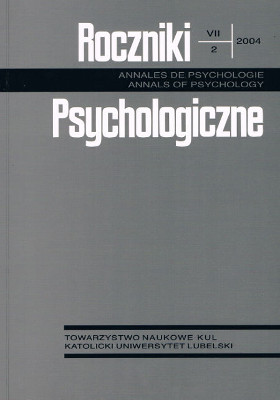Attachment styles and parental attitudes: An empirical research
Abstract
The present study verifies in the Polish cultural context results of previously conducted studies in links between the attachment quality and the quality of parental care. Measures of insecure childhood attachment styles to both parents, secure and insecure adolescent attachment styles, along with measures of parental attitudes of both parents were completed by a sample of 85 secondary school students (54 girls and 31 boys). Insecure (avoidant and anxious / ambivalent) childhood attachment styles to mother correlated positively with rejecting and demanding maternal attitudes and negatively with loving, protecting and casual attitude. The same kind of links was observed: a) between insecure childhood attachment styles to father and paternal attitudes; b) between insecure adolescent attachment styles and parental attitudes of both parents. Secure adolescent attachment style correlated positively with loving, protecting and casual parental attitudes of both parents and negatively with rejecting and demanding attitudes. These results support the results obtained in studies conducted mainly in the Anglo-Saxon cultural context where similar links between attachment quality and quality of parental care were found.
References
Ainsworth, M., Witting, B. A. (1969). Attachment and the exploratory behaviour of one-year-olds in a strange situation. W: B. M. Foss (red.), Determinants of infant behaviour. IV (s. 113-136). London: Methuen.
Bartholomew, K. (1990). Avoidance of intimacy: An attachment perspective. Journal of Social and Personal Relationschips, 7, 147-178.
Bartholomew, K., Horowitz, L. M. (1991). Attachment styles among young adults: A test for a four category model. Journal of Personality and Social Psychology, 61, 226-244.
Bartholomew, K., Shaver, P. R. (1998). Methods of assessing adult attachment: Do they converge? W: J. A. Simpson, W. S. Rholes (red.), Attachment theory and close relationship (s. 25-45). New York: The Guilford Press.
Belsky, J. (1999). Interactional and contextual determinants of attachment security. W: J. Cassidy, P. R. Shaver (red.), Handbook of attachment: Theory, research, and clinical application (s. 249-264). New York: The Guilford Press.
Belsky, J., Rosenberger, K., Crnic, K. (1995). The origins of attachment security: „Classical” and contextual determinants. W: S. Goldberg, R. Muir, J. Kerr (red.), Attachment theory: Social, develepmental, and clinical perspectives (s. 153-183). Hillsdale, NJ: The Analytic Press.
Bowlby, J. (1982). Costruzione e rottura dei legami affettivi. Milano: Raffaello Cortina Editore.
Bowlby, J. (1989). Una base sicura: Applicazioni cliniche della teoria dell'attaccamento. Milano: Raffaello Cortina Editore.
Bowlby, J. (1999). Attaccamento e perdita. Vol. I: L'attaccamento alla madre. Torino: Bollati Boringhieri.
Bowlby, J. (2000a). Attaccamento e perdita. Vol. II: La separazione dalla madre: Angoscia e rabbia. Torino: Bollati Boringhieri.
Bowlby, J. (2000b). Attaccamento e perdita. Vol. III: La perdita della madre: Tristezza e depressione. Torino: Bollati Boringhieri.
Brennan, K. A., Clark, C. L., Shaver, P. R. (1998). Self-report measurement of adult attachment: An integrative overview. W: J. A. Simpson, W. S. Rholes (red.), Attachment theory and close relationship (s. 46-76). New York: The Guilford Press.
Cialdini, R. B., Kenrick, D. T., Neuberg, S. L. (2002). Psychologia społeczna. Gdańsk: Gdańskie Wydawnictwo Psychologiczne.
DeWolff, M. S., van Ijzendoorn, M. H. (1997). Sensitivity and attachment: A meta-analysis on parental antecedents of infant attachment. W: Child Development, 68, 571-591.
Feeney, J. A., Noller, P., Hanrahan, M. (1994). Assessing adult attachment. W: M. B. Sperling, W. H. Berman (red.), Attachment in adults: Clinical and developmental perspectives (s. 128-152). New York: The Guilford Pres.
Fraley, R. C., Waller, N. G. (1998). Adult attachment patterns: A test of the typological model. W: J. A. Simpson, W. S. Rholes (red.), Attachment theory and close relationship (s. 77-114). New York: The Guilford Press.
Gasiul, H. (2001). W poszukiwaniu podstaw rozwoju ja emocjonalnego. Warszawa: Wydawnictwo Akademickie „Żak”.
Goldsmith, H. N., Alansky, J. A. (1987). Maternal and infant temperamental predictors of attachment: A meta-analityc review. Journal of Consulting and Clinical Psychology, 55, 805-816.
Griffin, D. W., Bartholomew, K. (1994). Models of the self and other: Fundamental dimensions underlying measures of adult attachment. Journal of Personality and Social Psychology, 67, 430-445.
Hazan, C., Shaver, P. R. (1987). Romantic love conceptualized as an attachment process. Journal of Personality and Social Psychology, 52, 511-524.
Kowalski, S. (1984). Kwestionariusz stosunków między rodzicami a dziećmi A. Roe i M. Siegelmana. Warszawa: Wydawnictwo Radia i Telewizji.
Roe, A. (1957). Early determinants of vocational choice. Journal of Conseling Psychology, 4, 212-217.
Roe, A.., Siegelman, M. (1963). A Parent-Child Relations Questionnaire. Child Development, 34, 355-369.
Rothbard, J. C., Shaver, P. R. (1994). Continuity of attachment across the life span. W: M. B. Sperling, W. H. Berman (red.), Attachment in adults: Clinical and developmental perspectives (s. 31-71). New York: The Guilford Press.
Shaver, P. R., Hazan, C., Bradshow, D. (1988). Love as attachment: The integration of three behavioral systems. W: R. J. Sternberg, M. Barnes (red.), The psychology of love (s. 68-99). New Haven: Yale University Press.
Simpson, J. A., Rholes, W. S. (1998). Attachment in adulthood. W: J. A. Simpson, W. S. Rholes (red.), Attachment theory and close relationship (s. 3-21). New York: The Guilford Press.
Turner, J. S., Helms, D. B. (1999). Rozwój człowieka. Warszawa: Wydawnictwa Szkolne i Pedagogiczne.
Van den Boon, D. (1990). Preventive intervention and the quality of mother-infant interaction and infant exploration in irritable infants. W: W. Koops i in. (red.), Development psychology behind the dike (s. 249-270). Amsterdam: Eburon.
Van Ijzendoorn, M. H., Juffer, M., Duyvesteyn, M. (1995). Breaking the intergenerational cyrcle of insecure attachment: A review of the effects of attachment-based interventions on maternal sensitivity and infant security. Journal of Child Psychology and Psychiatry, 36, 225-248.
Vasta, K., Haith, M. M., Miller, S. A. (1995). Psychologia dziecka. Warszawa: Wydawnictwa Szkolne i Pedagogiczne.
Vaughn, B. E., Bost, K. K. (1999). Attachment and temperament: Redundant, independent, or interacting influences on interpersonal adaptation and personality development? W: J. Cassidy, P. R. Shaver (red.), Handbook of attachment: Theory, research, and clinical application (s. 198-225). New York: The Guilford Press.
Copyright (c) 2004 Roczniki Psychologiczne

This work is licensed under a Creative Commons Attribution-NonCommercial-NoDerivatives 4.0 International License.


